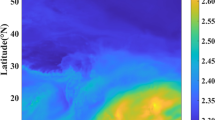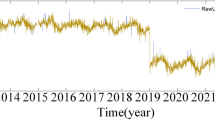Abstract
Wind gusts are a major cause of damage to property and the natural environment and a source of noise in seismic networks such as the USArray Transportable Array. Wind gusts cause ground motion through shear stresses, pressure fluctuations and vegetation flexing. Herein, we demonstrate the presence of a seismic response signature to wind gusts at sites across the contiguous USA and explore important geophysical factors that determine the precise nature of wind gust–seismic response relationships. There is a consistent seismic response to wind gusts that is typically manifest at relatively low frequency (0.05–0.1 Hz). However, there is also a marked seasonality in the seismic frequency of peak response, possibly due to seasonal differences in atmospheric conditions and/or vegetation and soil mediation of the atmosphere–ground interaction. The gust–seismic response functions also exhibit a clear dependence on (1) distance from the coast, (2) land cover, (3) topographic complexity and (4) lithology. We propose a generalized methodology to extract wind gust magnitude distributions from seismic networks. Although initial results from this model overestimate the spatial variability in wind gusts as measured by meteorological networks, the analyses described here highlight the potential for new methods to remove wind gust noise from seismic time series and potentially to derive quantitative wind gust estimates from seismic observations.











Similar content being viewed by others
References
Anderson DL et al (1976) The Viking seismic experiment. Science 194:1318–1321
Ansari A, Hosseini KA (2014) Broadband seismic network of Iran and increasing quality of seismic recordings. Seismol Res Lett 85:878–888
ASCE (1998) Minimum design loads for buildings and other structures. American Society of Civil Engineers, Reston, VA. ISBN 9780784412916
Bachrach R, Dvorkin J, Nur A (1998) High-resolution shallow-seismic experiments in sand, part II: velocities in shallow unconsolidated sand. Geophysics 63:1234–1240
Bardal LM, Sætran LR (2016) Wind gust factors in a coastal wind climate. Energy Procedia 94:417–424
Barthelmie RJ, Pryor SC (2003) Can satellite sampling of offshore wind speeds realistically represent wind speed distributions? J Appl Meteorol 42:83–94
Breiman L, Friedman J, Stone CJ, Olshen RA (1984) Classification and regression trees. CRC Press, Boca Raton
Bromirski PD (2009) Earth vibrations. Science 324:1026–1027
Browning K (2004) The sting at the end of the tail: damaging winds associated with extratropical cyclones. Q J R Meteorol Soc 130:375–399
Changnon SA (2011) Windstorms in the United States. Nat Hazards 59:1175–1187
Changnon SA, Changnon JM (1992) Storm catastrophes in the United States. Nat Hazards 6:93–107
Choi EC, Hidayat FA (2002) Gust factors for thunderstorm and non-thunderstorm winds. J Wind Eng Ind Aerodyn 90:1683–1696
Clark TL, Farley R (1984) Severe downslope windstorm calculations in two and three spatial dimensions using an elastic interactive grid nesting: a possible mechanism for gustiness. J Atmos Sci 41:329–350
Cook NJ (1986) The designer’s guide to wind loading of building structures: part 1: background, damage survey, wind data and structural classification. Butterworths, London. ISBN 978-0408008709
De Angelis S, Bodin P (2012) Watching the wind: seismic data contamination at long periods due to atmospheric pressure-field-induced tilting. Bull Seismol Soc Am 102:1255–1265
Della-Marta PM, Liniger MA, Appenzeller C, Bresch DN, Köllner-Heck P, Muccione V (2010) Improved estimates of the European winter windstorm climate and the risk of reinsurance loss using climate model data. J Appl Meteorol Climatol 49:2092–2120
Edwards WN, Asudeh I, Andrews C, Jensen G, Murphy F, Ashlie R (2012) Seismic evaluation of a multipurpose tower in Yellowknife, Northwest Territories, Canada. Seismol Res Lett 83:787–797
Farr TG et al (2007) The shuttle radar topography mission. Rev Geophys. https://doi.org/10.1029/2005RG000183
Fathi-Moghadam M (2007) Characteristics and mechanics of tall vegetation for resistance to flow. Afr J Biotech 6:475
Gardiner BA (1992) Mathematical modelling of the static and dynamic characteristics of plantation trees. In: Math modelling of forest ecosystems, pp 40–61
Giammanco IM, Schroeder JL, Masters FJ, Vickery PJ, Krupar RJ III, Balderrama J-A (2016) Influences on observed near-surface gust factors in landfalling US Gulf Coast hurricanes: 2004–08. J Appl Meteorol Climatol 55:2587–2611
Gimbert F, Tsai VC (2015) Predicting short-period, wind-wave-generated seismic noise in coastal regions. Earth Planet Sci Lett 426:280–292
Hand E (2014) A boom in boomless seismology. Science 345:720–721
Harper BA, Kepert JD, Ginger JD (2010) Guidelines for converting between various wind averaging periods in tropical cyclone conditions. Rep: WMO-TD-1555. World Meteorological Organization, Geneva, Switzerland. https://www.wmo.int/pages/prog/www/tcp/documents/WMO_TD_1555_en.pdf. Accessed 15 Dec 2017
Homer C et al (2015) Completion of the 2011 National Land Cover Database for the conterminous United States—representing a decade of land cover change information. Photogramm Eng Remote Sens 81:345–354
Hu W, Pryor SC, Letson F, Tytell J, Barthelmie RJ (2017) Investigation of gust–seismic relationships and applications to gust detection. J Geophys Res Atmos 122:140–151
Hu W, Letson F, Barthelmie R, Pryor S (2018a) Wind gust characterization at wind turbine relevant heights in moderately complex terrain. J Appl Meteorol Climatol 57:1459–1476. https://doi.org/10.1175/JAMC-D-18-0040.1
Hu W, Letson F, Barthelmie RJ, Pryor SC (2018b) Wind gust characterization at wind turbine relevant heights in moderately complex terrain. J Appl Meteorol Climatol 57:1459–1476
Jacques AA, Horel JD, Crosman ET, Vernon F, Tytell J (2016) The Earthscope US transportable array 1 Hz surface pressure dataset. Geosci Data J 3:29–36. https://doi.org/10.1002/gdj3.37
Jacques AA, Horel JD, Crosman ET, Vernon FL (2017) Tracking mesoscale pressure perturbations using the USArray Transportable Array. Mon Weather Rev 145:3119–3142. https://doi.org/10.1175/mwr-d-16-0450.1
Kerzenmacher T, Gardiner B (1998) A mathematical model to describe the dynamic response of a spruce tree to the wind. Trees 12:385–394
Letson F, Pryor SC, Barthelmie RJ, Hu W (2018) Observed gust wind speeds in the coterminous United States, and their relationship to local and regional drivers. J Wind Eng Ind Aerodyn 173:199–209
Lott FF, Ritter JR, Al-Qaryouti M, Corsmeier U (2017) On the analysis of wind-induced noise in seismological recordings. Pure Appl Geophys 174:1453–1470
McNamara DE, Buland RP (2004) Ambient noise levels in the continental United States. Bull Seismol Soc Am 94:1517–1527
Meyers MP, Snook JS, Wesley DA, Poulos GS (2003) A Rocky Mountain storm. Part II: the forest blowdown over the west slope of the northern Colorado mountains—observations, analysis, and modeling. Weather Forecast 18:662–674
Mortensen NG, Landberg L, Troen I, Lundtang Petersen E, Rathmann O, Nielsen M (1999) Wind atlas analysis and application program (WAsP): vol. 3: utility programs. Risø National Laboratory, Roskilde
Naderyan V, Hickey CJ, Raspet R (2016) Wind-induced ground motion. J Geophys Res Solid Earth 121:917–930
Nadolski V (1998) Automated surface observing system (ASOS) user’s guide. National Oceanic and Atmospheric Administration, Department of Defense, Federal Aviation Administration, United States Navy
Nguyen Sinh H, Lombardo FT, Letchford CW, Rosowsky DV (2016) Characterization of joint wind and ice hazard in Midwestern United States. Nat Hazards Rev 17:04016004
NOAA (2004) Automated Surface Observing System (ASOS) release note, software version 2.79. National Oceanic and Atmospheric Administration, Department of Defense, Federal Aviation Administration, United States Navy
NOAA (2016) Automated surface observing system. https://www.ncdc.noaa.gov/data-access/land-based-station-data/land-based-datasets/automated-surface-observing-system-asos. Accessed 10 Apr 2016
Orwig KD, Schroeder JL (2007) Near-surface wind characteristics of extreme thunderstorm outflows. J Wind Eng Ind Aerodyn 95:565–584
Peterson J (1993) Observations and modeling of seismic background noise. U.S. Geological Survey Technical Report, Open-File Report 93-322, U.S. Geological Survey Technical Report, Open-File Report 93-322
Pryor SC, Schoof JT (2010) Importance of the SRES in projections of climate change impacts on near-surface wind regimes. Meteorol Z 19:267–274
Pryor SC, Nielsen M, Barthelmie RJ, Mann J (2004) Can satellite sampling of offshore wind speeds realistically represent wind speed distributions? Part II: quantifying uncertainties associated with sampling strategy and distribution fitting methods. J Appl Meteorol 43:739–750
Pryor SC, Conrick R, Miller C, Tytell J, Barthelmie RJ (2014) Intense and extreme wind speeds observed by anemometer and seismic networks: an eastern US case study. J Appl Meteorol Climatol 53:2417–2429
Schmitt IV CV (2009) A quality control algorithm for the ASOS ice free wind sensor. In: Preprints, 13th conference on integrated observing and assimilation systems for atmosphere, oceans, and land surface, Phoenix, AZ, American Meteorological Society A
Seguro J, Lambert T (2000) Modern estimation of the parameters of the Weibull wind speed distribution for wind energy analysis. J Wind Eng Ind Aerodyn 85:75–84
Sheridan P (2011) Review of techniques and research for gust forecasting parameterization. Forecasting Research Technical Report 570, UK Met Office, Exeter, Forecasting Research Technical Report 570, UK Met Office, Exeter
Smart D, Browning K (2014) Attribution of strong winds to a cold conveyor belt and sting jet. Q J R Meteorol Soc 140:595–610
Smith AB, Katz RW (2013) US billion-dollar weather and climate disasters: data sources, trends, accuracy and biases. Nat Hazards 67:387–410
Sufri O, Koper KD, Burlacu R, de Foy B (2014) Microseisms from superstorm Sandy. Earth Planet Sci Lett 402:324–336. https://doi.org/10.1016/j.epsl.2013.10.015
Suomi I, Vihma T (2018) Wind gust measurement techniques—from traditional anemometry to new possibilities. Sensors 18:1300
Suomi I, Gryning SE, Floors R, Vihma T, Fortelius C (2015) On the vertical structure of wind gusts. Q J R Meteorol Soc 141:1658–1670
Tanimoto T, Valovcin A (2015) Stochastic excitation of seismic waves by a hurricane. J Geophys Res Solid Earth 120:7713–7728. https://doi.org/10.1002/2015jb012177
Tanimoto T, Wang J (2018) Low-frequency seismic noise characteristics from the analysis of co-located seismic and pressure data. J Geophys Res Solid Earth 123:5853–5885
TASS (2012) TA station selection strategy and recommendations central and eastern United States. USArray TA Station Selection (TASS) Report
Tytell J et al (2016) The USArray Transportable array as a platform for weather observation and research. Bull Am Meteorol Soc 97:603–619. https://doi.org/10.1175/BAMS-D-14-00204.1
Wakimoto RM (2001) Convectively driven high wind events. In: Doswell C (ed) Severe Convective Storms. Springer, Washington, pp 255–298
Welch P (1967) The use of fast Fourier transform for the estimation of power spectra: a method based on time averaging over short, modified periodograms. IEEE Trans Audio Electroacoust 15:70–73
Withers MM, Aster RC, Young CJ, Chael EP (1996) High-frequency analysis of seismic background noise as a function of wind speed and shallow depth. Bull Seismol Soc Am 86:1507–1515
Wolin E et al (2015) Seasonal and diurnal variations in long-period noise at SPREE stations: the influence of soil characteristics on shallow stations’ performance. Bull Seismol Soc Am 105:2433–2452
Yang Q, Gao R, Bai F, Li T, Tamura Y (2018) Damage to buildings and structures due to recent devastating wind hazards in East Asia. Nat Hazards 92:1321–1353
Young G, Kristensen L (1992) Surface-layer gusts for aircraft operation. Bound-Layer Meteorol 59:231–242
Yu J, Raspet R, Webster J, Abbott J (2011) Wind noise measured at the ground surface. J Acoust Soc Am 129:622–632
Zimmerman RW, King MS (1986) The effect of the extent of freezing on seismic velocities in unconsolidated permafrost. Geophysics 51:1285–1290
Acknowledgements
This research was made possible by funding from National Science Foundation (1540393 and 1565505) and Cornell University’s David R. Atkinson Center for a Sustainable Future (ACSF-sp2279-2016). We are grateful to the work of the NWS in collecting and archiving the ASOS measurements (available from the National Centers for Environmental Information ftp://ncdc.noaa.gov/pub/data/asos-fivemin/) and to the USArray for their work with the Transportable Array (data available at: http://www.usarray.org/researchers/obs/transportable). The other data sets employed herein are available as follows: Lithology data are obtained from the United States Geologic Survey (https://mrdata.usgs.gov/geology/state/), the 2011 National Land Cover Database is available on https://www.mrlc.gov/nlcd2011.php, and high-resolution elevation data from the National Aeronautics and Space Administration’s Shuttle Radar Topography Mission are available on http://www2.jpl.nasa.gov/srtm/. The comments of two reviewers served to improve this manuscript and are gratefully acknowledged.
Author information
Authors and Affiliations
Corresponding authors
Additional information
Publisher's Note
Springer Nature remains neutral with regard to jurisdictional claims in published maps and institutional affiliations.
Electronic supplementary material
Below is the link to the electronic supplementary material.
Rights and permissions
About this article
Cite this article
Letson, F., Barthelmie, R.J., Hu, W. et al. Wind gust quantification using seismic measurements. Nat Hazards 99, 355–377 (2019). https://doi.org/10.1007/s11069-019-03744-8
Received:
Accepted:
Published:
Issue Date:
DOI: https://doi.org/10.1007/s11069-019-03744-8




